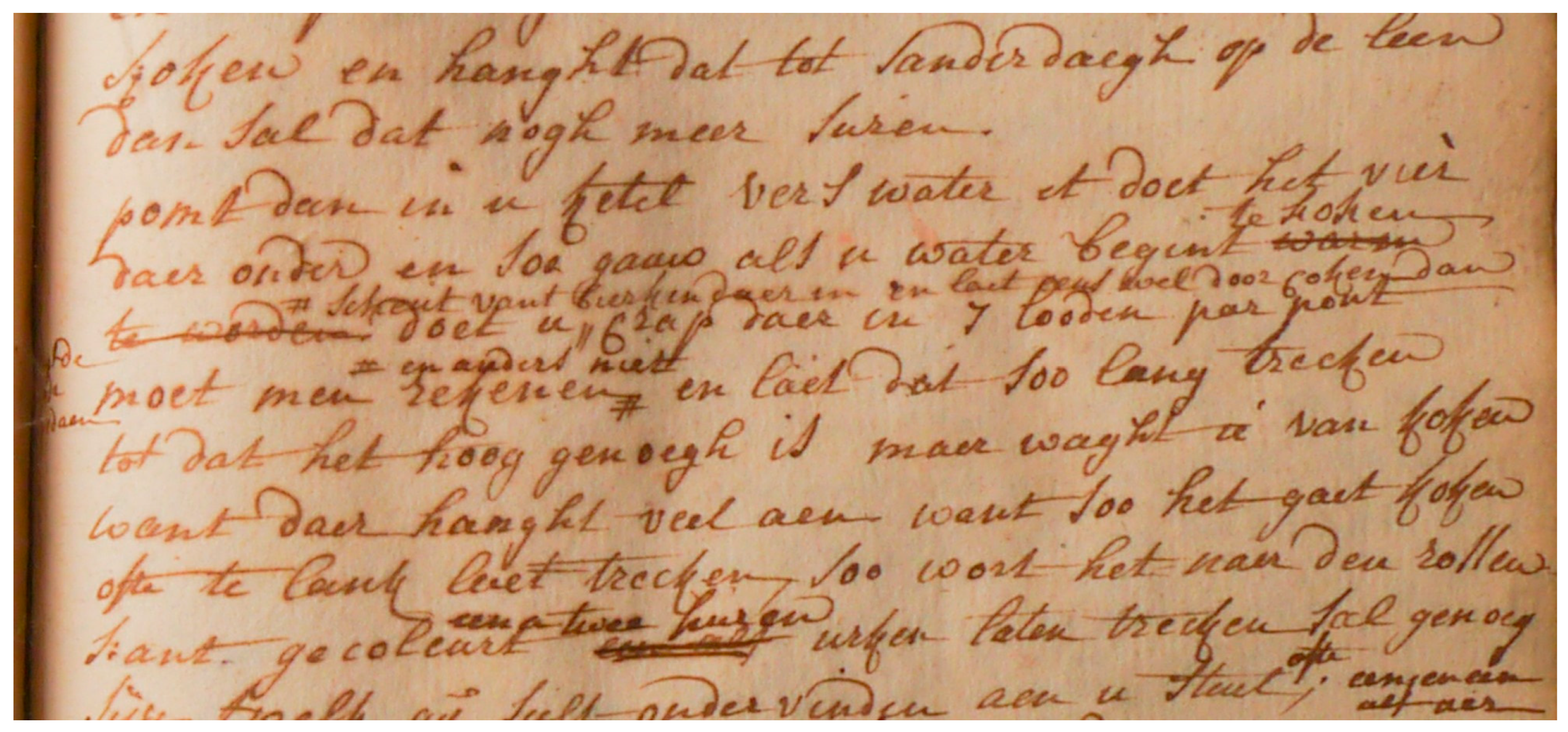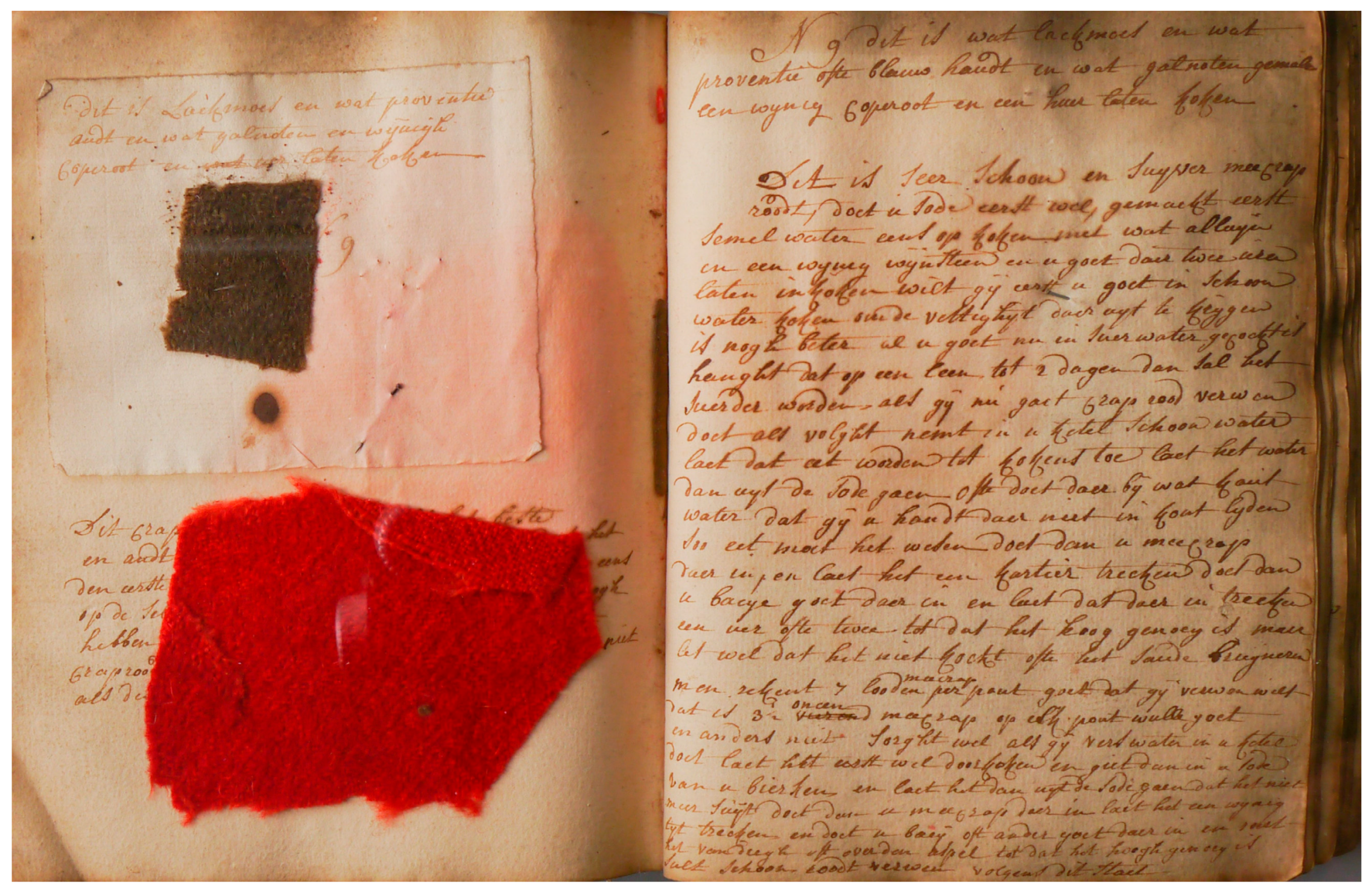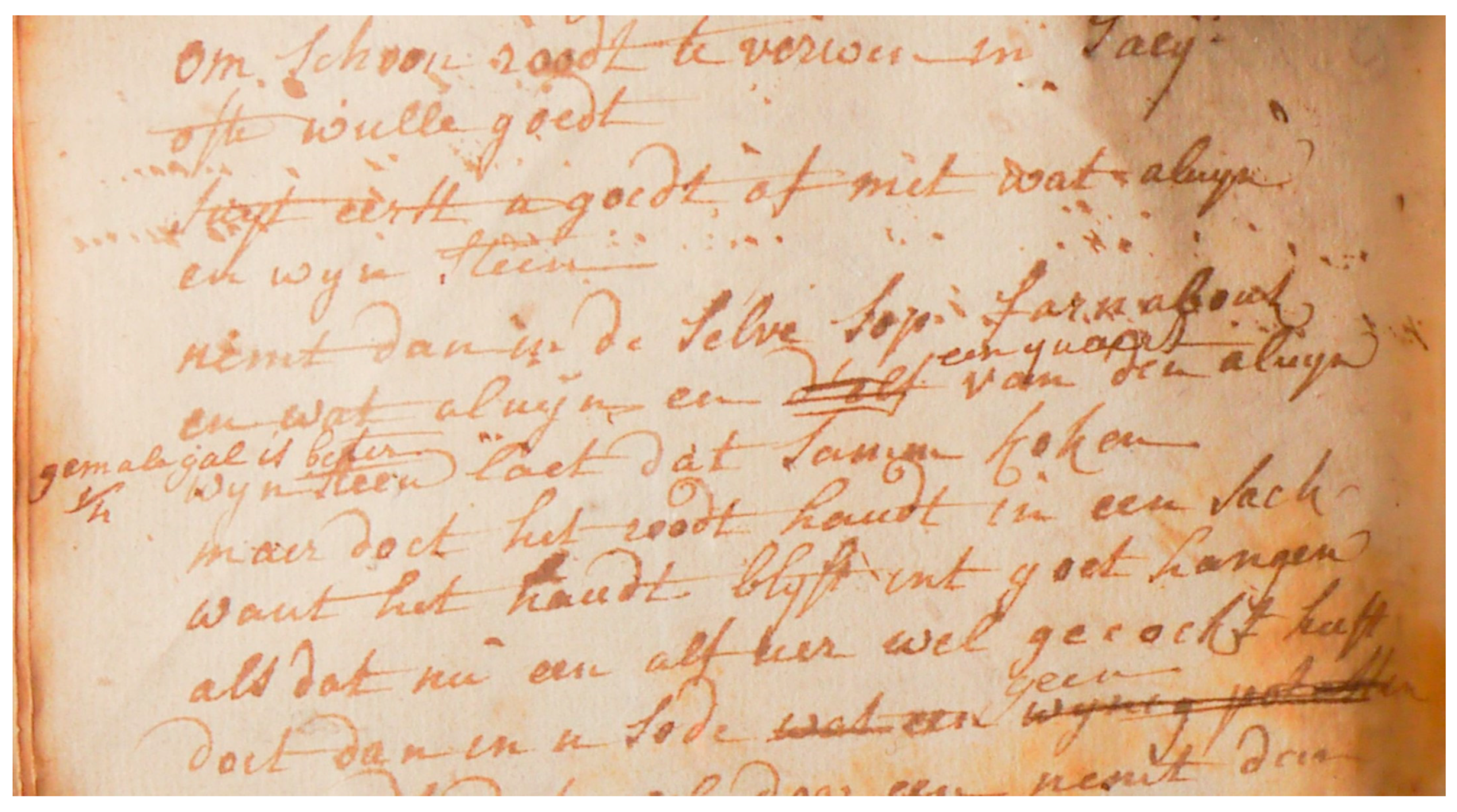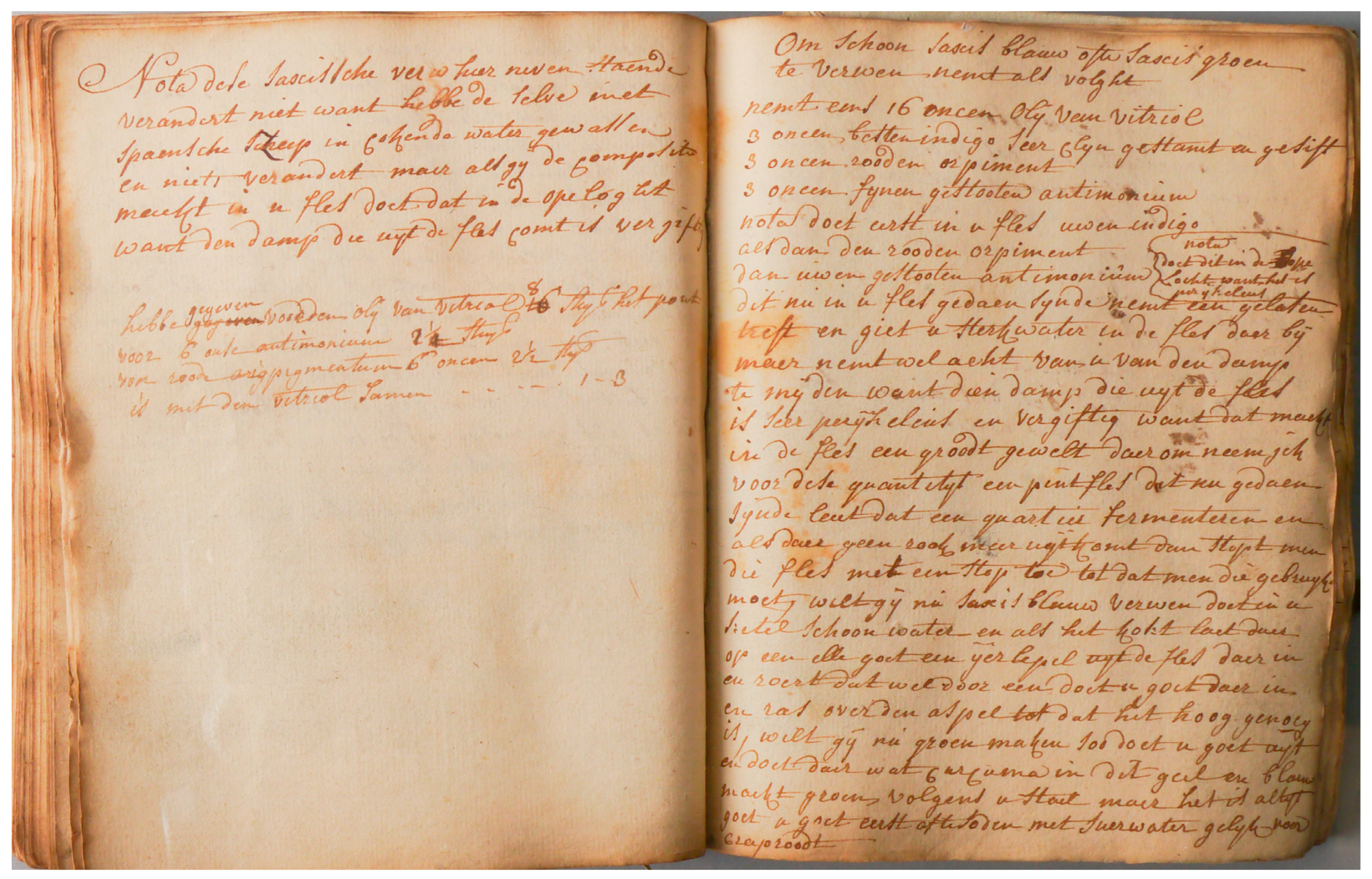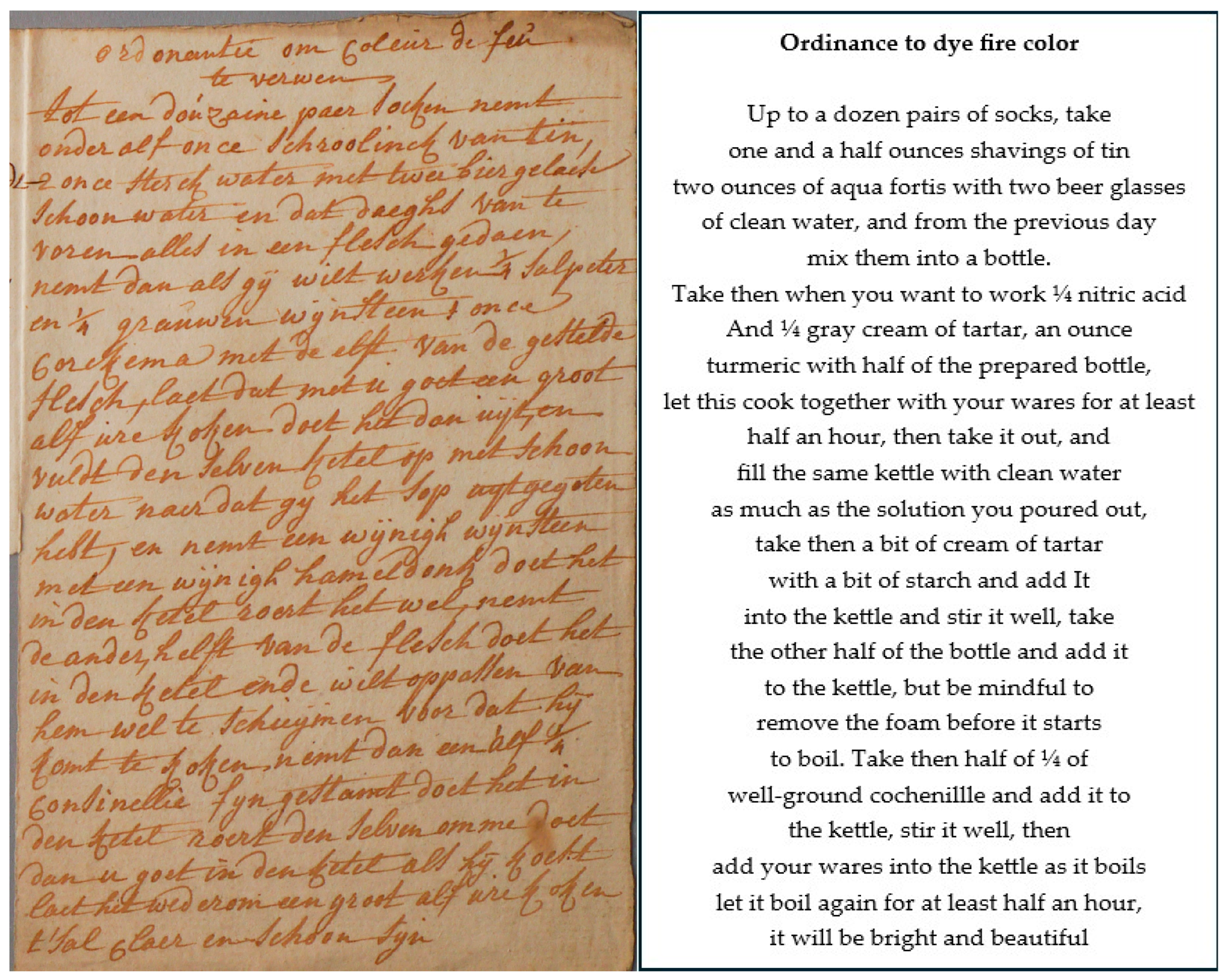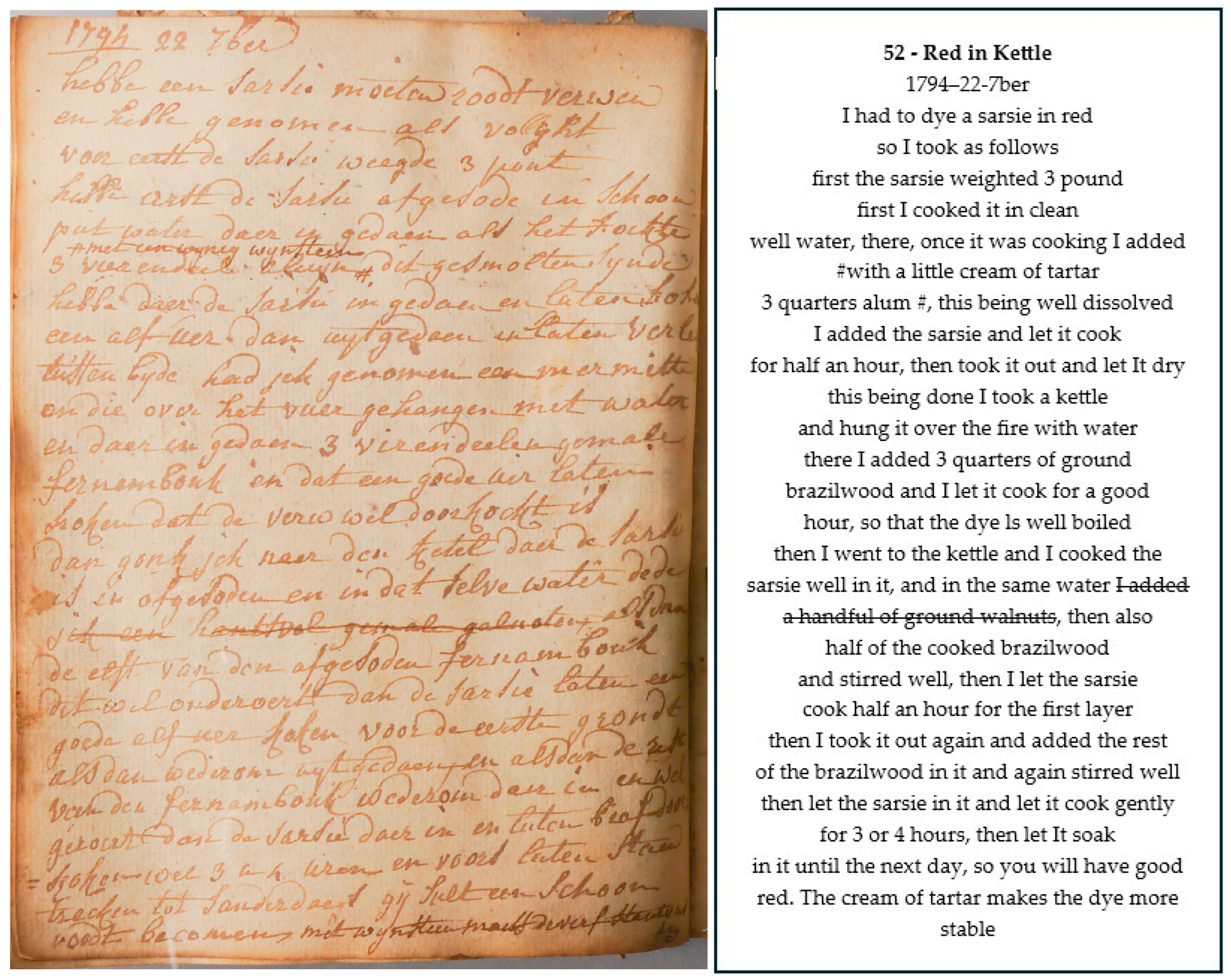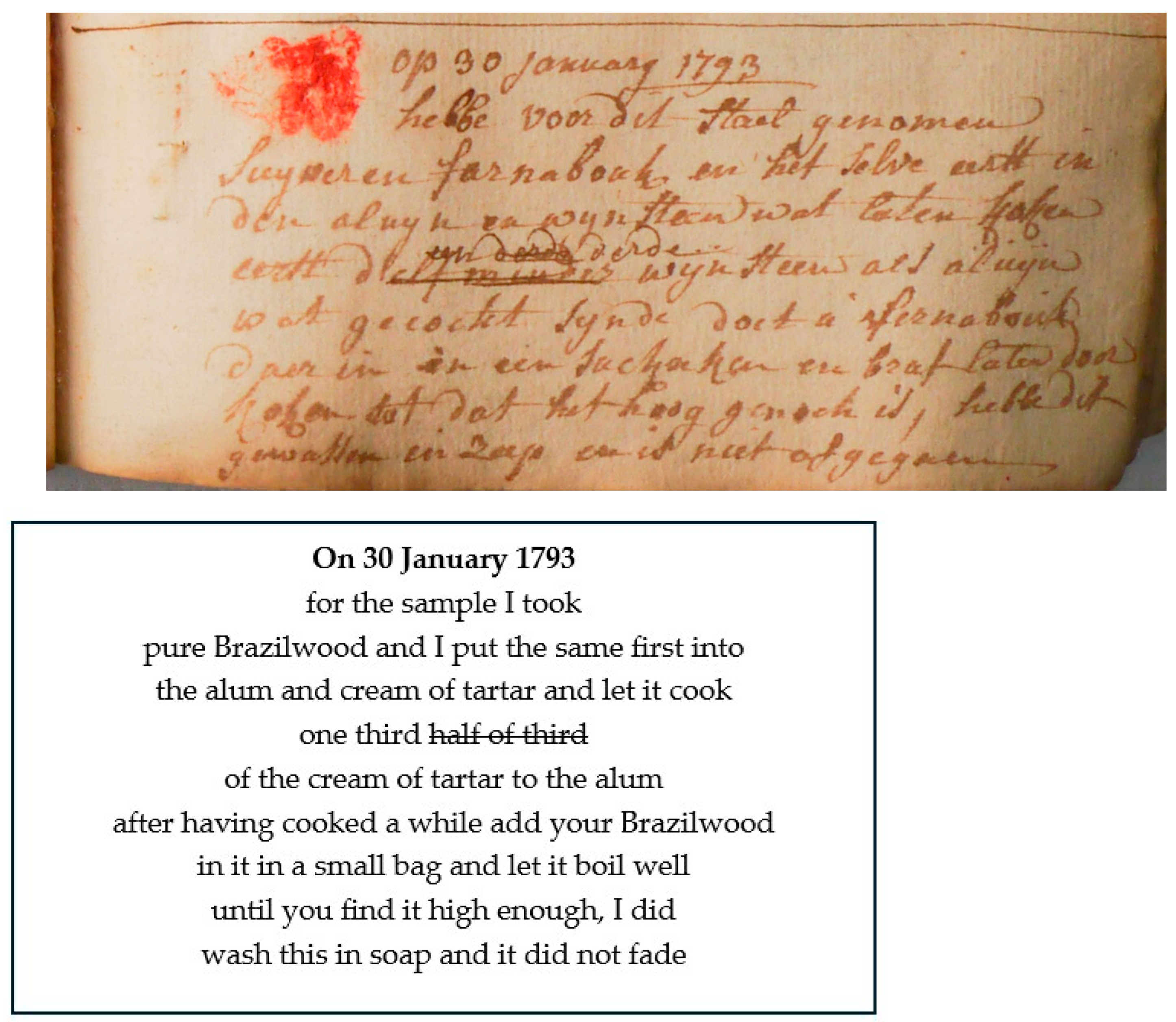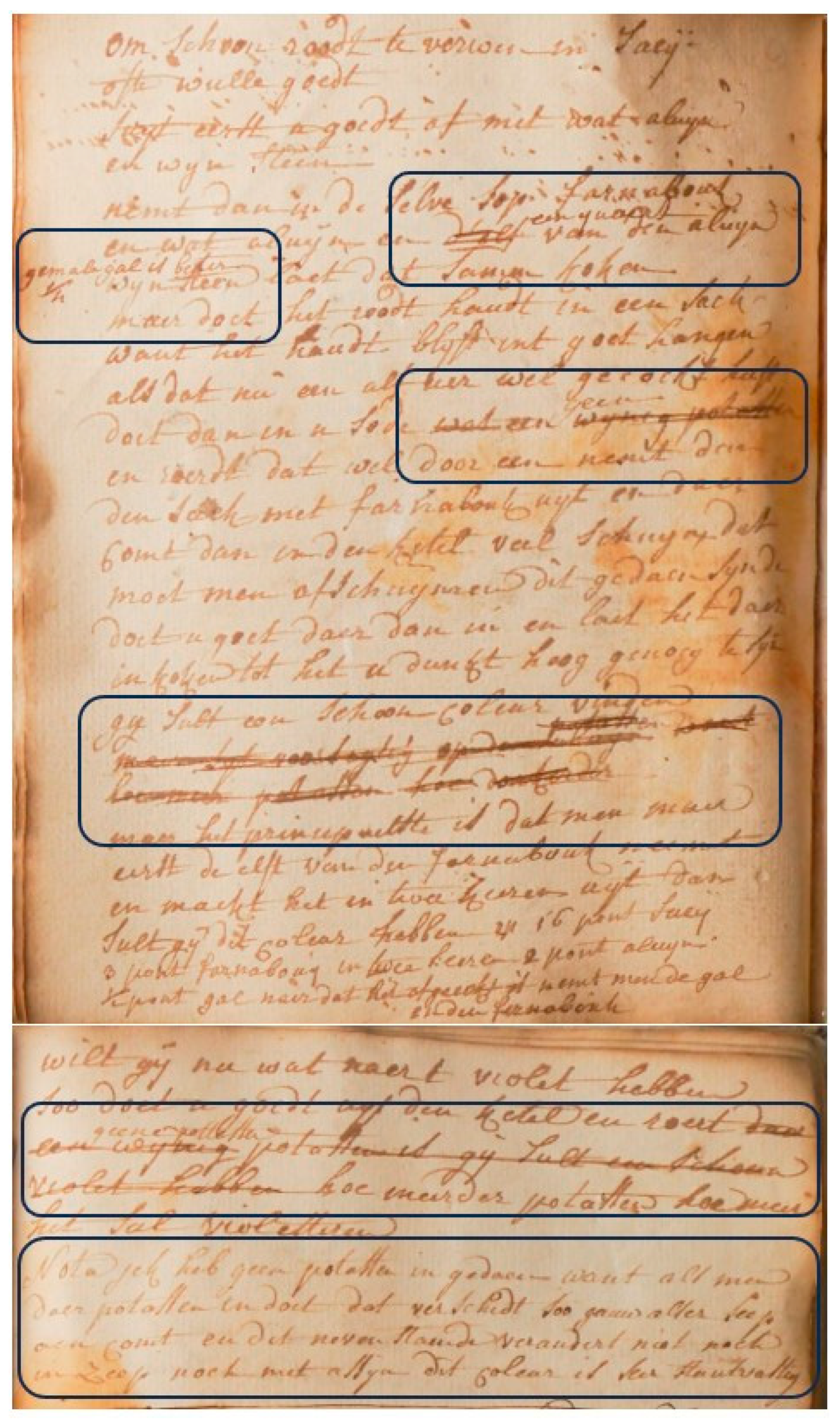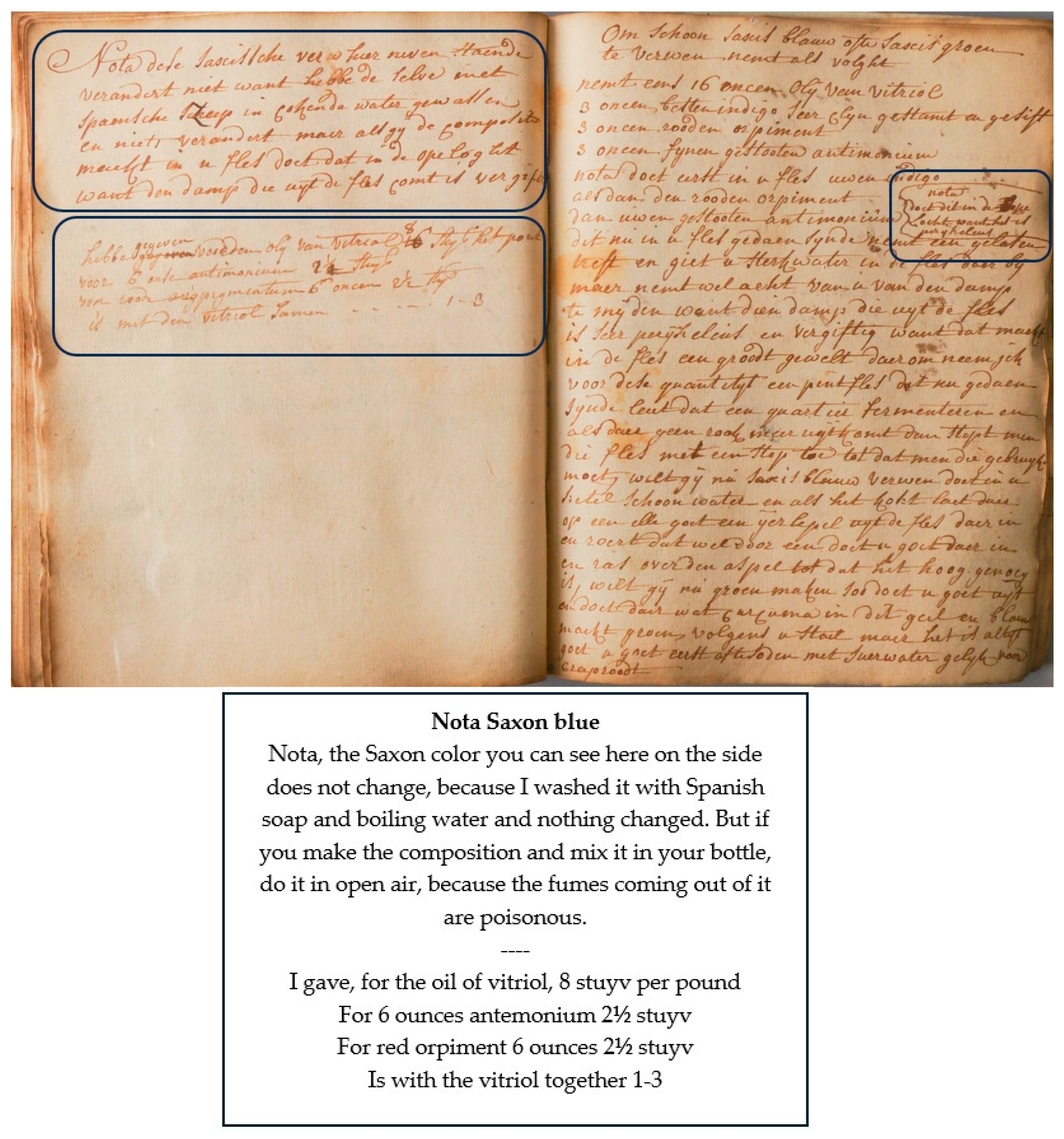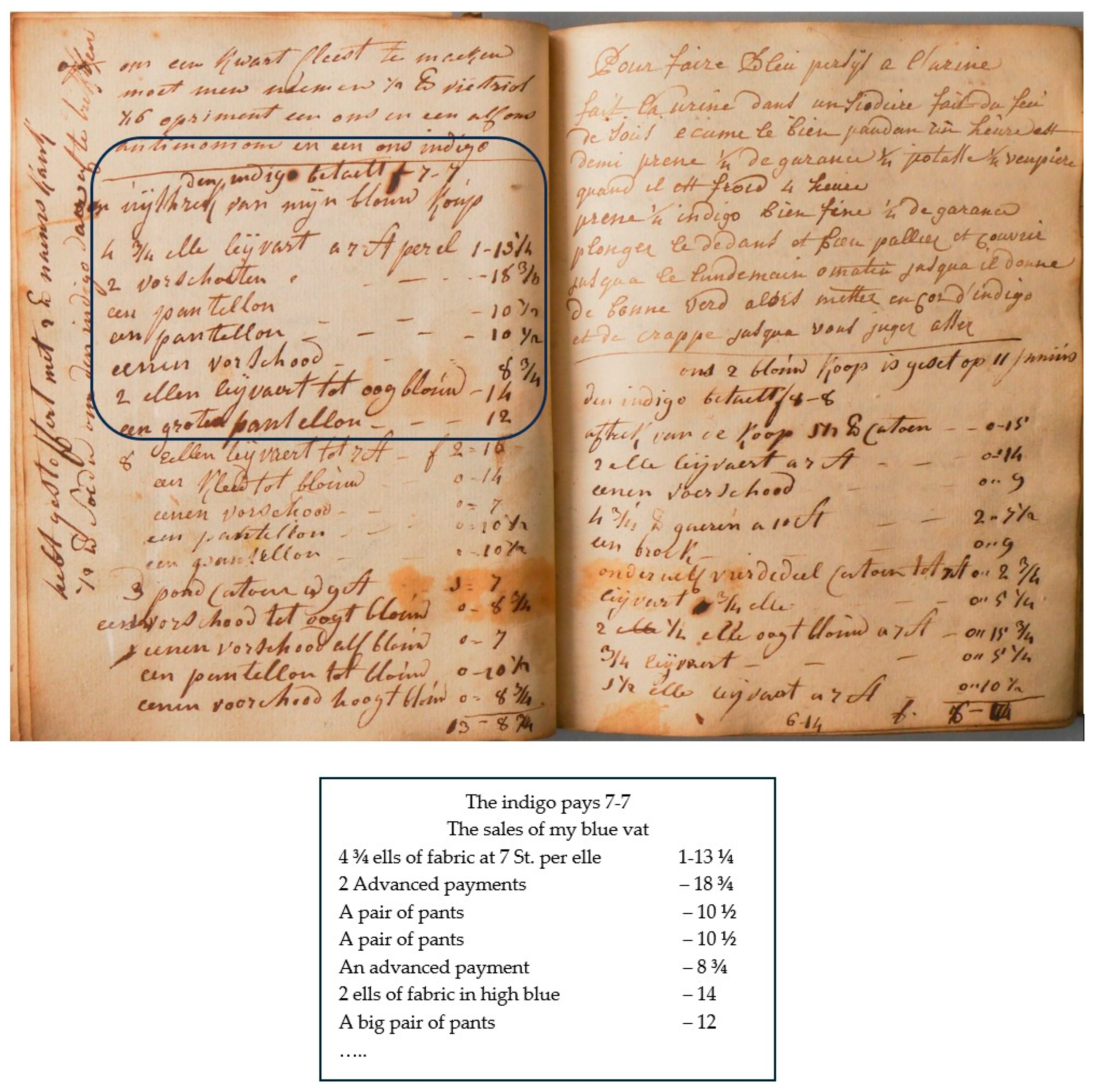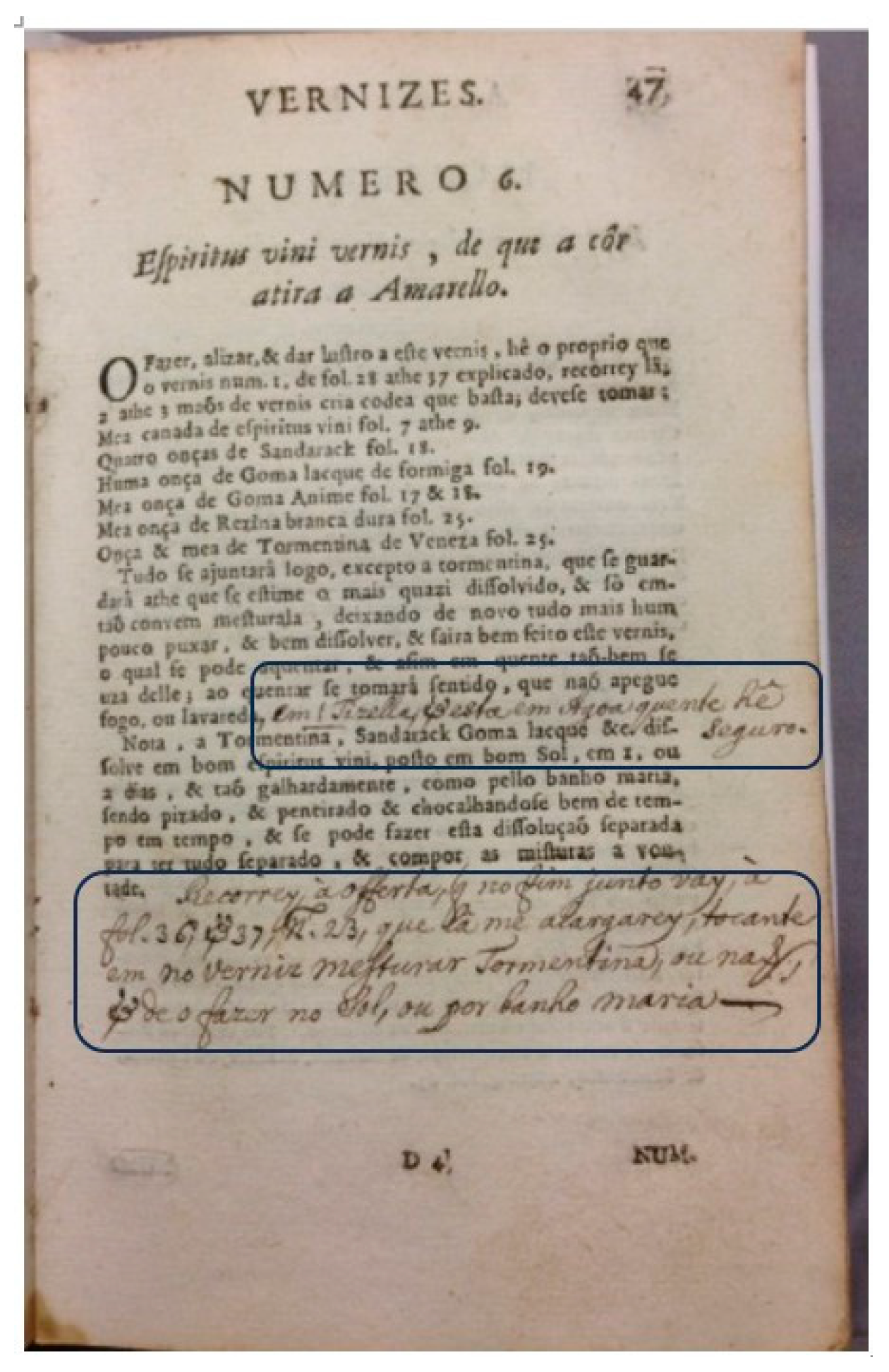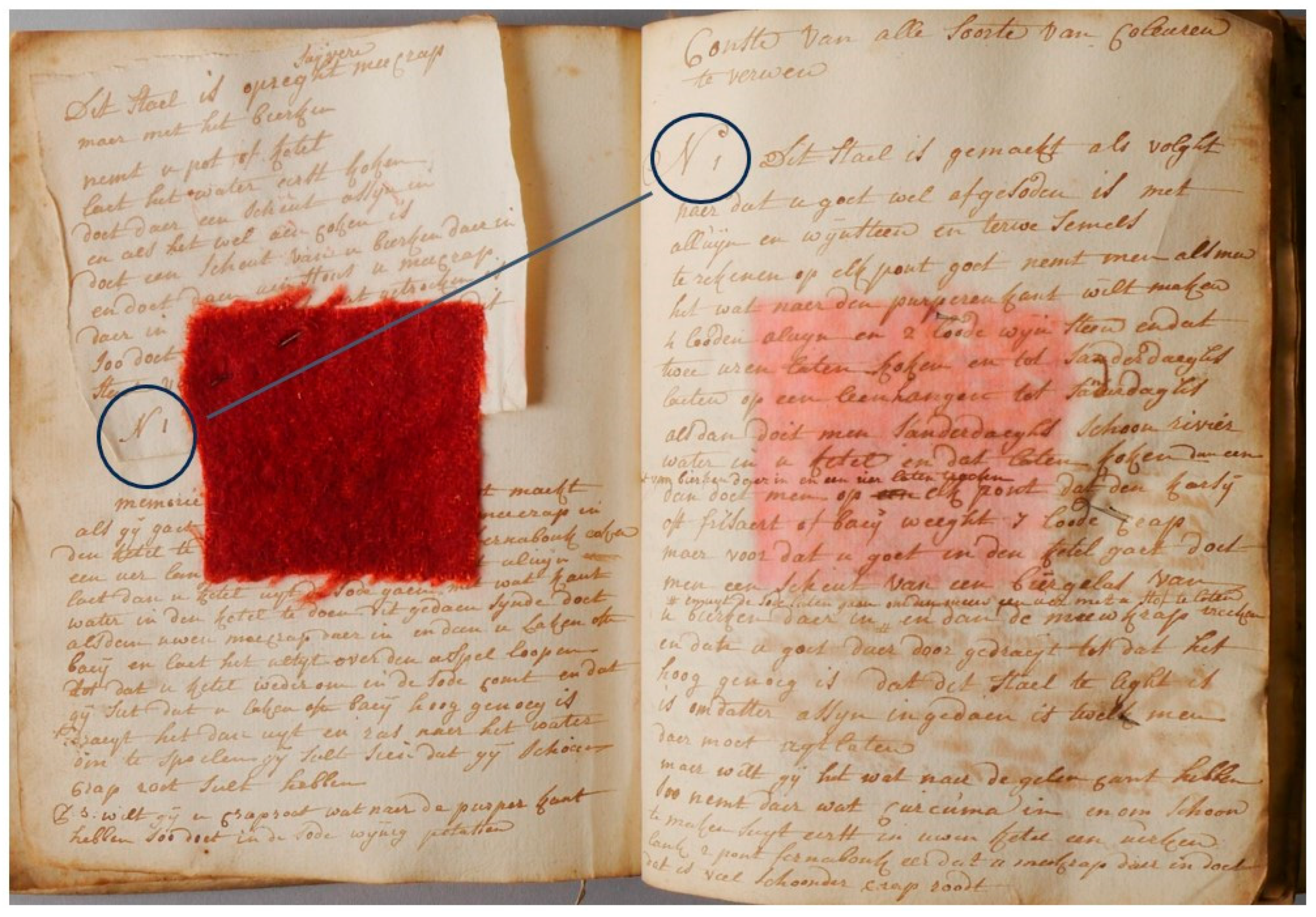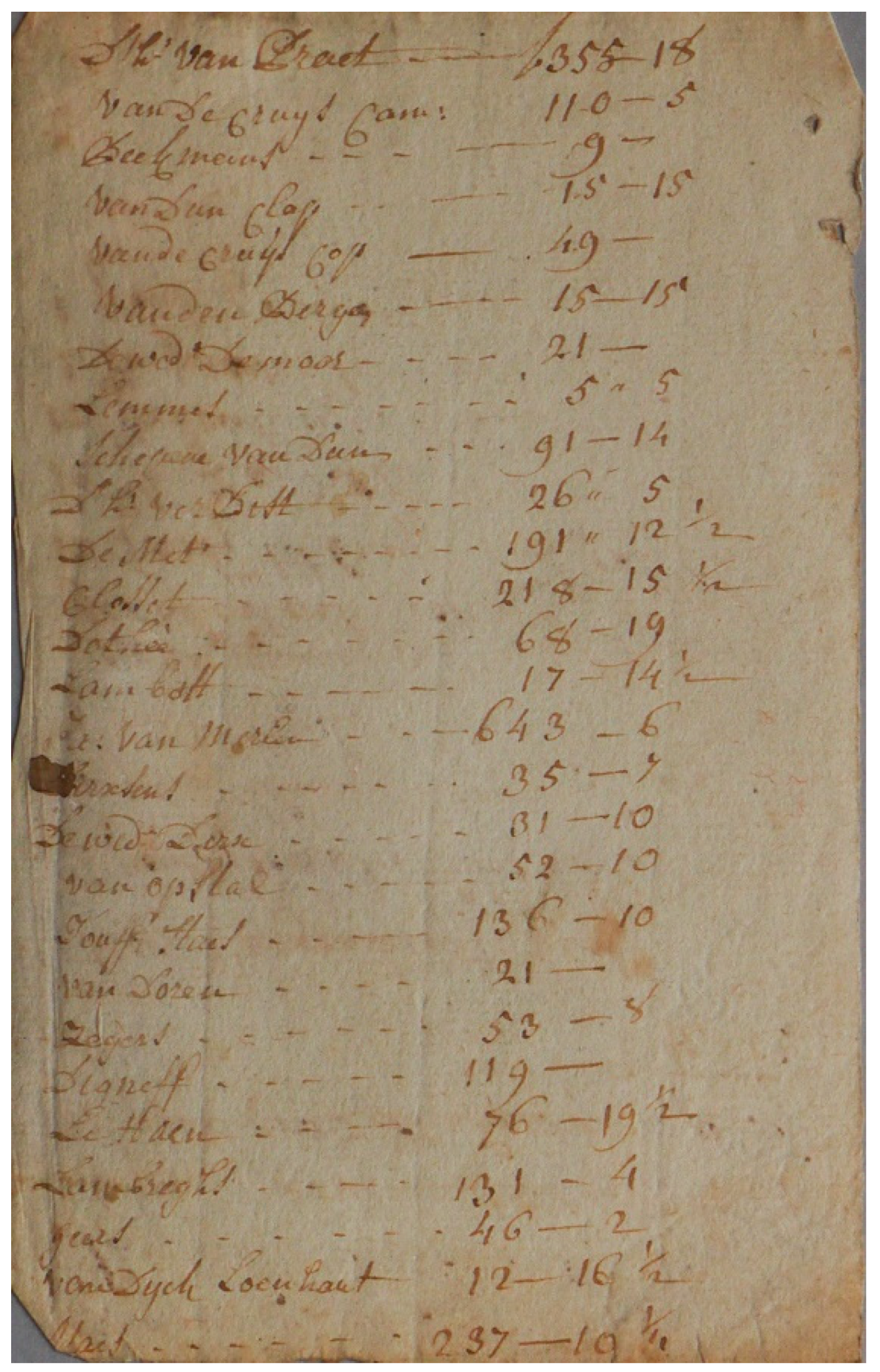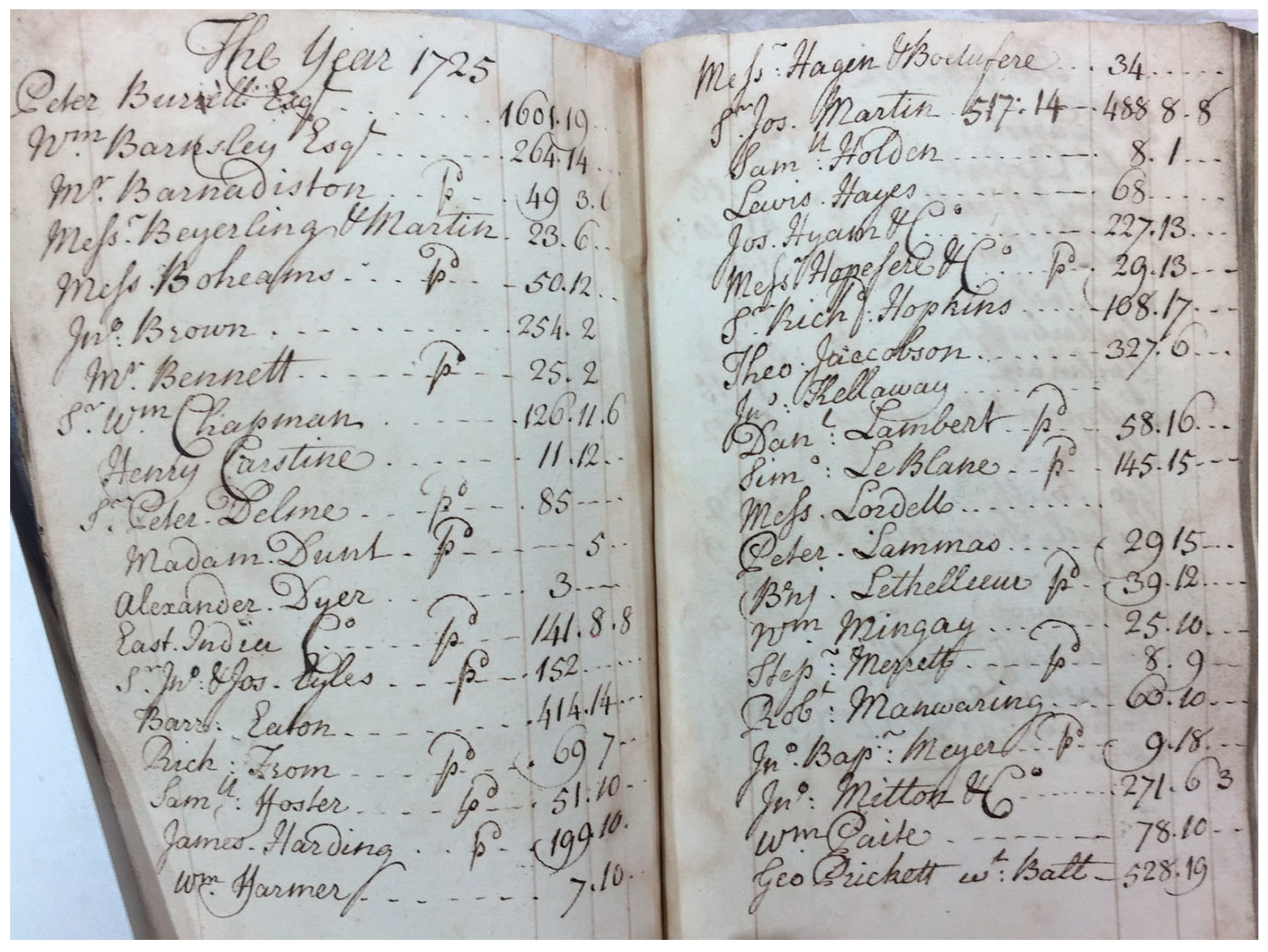1. Introduction
In previous research, we examined the socio-historical context and primary contents of an 18th-century Antwerp dyer’s manual, focusing on its role within a medium/small-sized dyeing enterprise [
1].
While this initial analysis provided valuable historical and contextual insights, it raises intriguing questions regarding the tracing of the dyer’s cognitive processes and the evolution of craft knowledge embedded within the manuscript. This paper delves into these intellectual and experimental aspects, examining the manuscript as a living record of the dyer’s thought processes, iterative refinements, and knowledge transmission strategies. By analyzing corrections, additions, and annotations in the manuscript, this study seeks to uncover the underlying cognitive frameworks and the dyer’s approach to knowledge development and refinement.
As we grew more familiar with the author’s writing style, it became evident that multiple textual elements formed recurring patterns beyond the conveying of information, rendering this type of research possible. The first notable element was the alternate use in recipes of the first-person perspective (“I did, I took”) and the second-person imperative (“You will see, take this”). Additionally, many of the recipes exhibited clear signs of modification, albeit in the form of written additions (
Figure 1), the pinning of notes (
Figure 2), and paratext
1 (
Figure 3 and
Figure 4). Furthermore, many recipes show repetitive word usage and fixed grammatical structures in the compiling; on the other hand, others do not show any of these repetitions and, contrarily, present unique words that are never repeated. The interplay of these elements, which are analyzed in detail in the following sections, suggests that the text was created as an evolving compendium, integrating both personal and externally sourced recipes, resembling a draft or a logbook more than a finalized technical treatise. We consequently decided to further investigate these aspects of the manuscript as they render it unique when compared to the more common instructional texts. The possibility of tracing and analyzing the thought process and the working methods of the dyer to contextualize them within the broader trends of the creation and transmission of artisanal knowledge contributes to our understanding of knowledge development in historical dye craft traditions.
2. Contents of the Antwerp Manuscript
When analyzing a direct source from the past, as a dyer’s manuscript like this one, it is fundamental to understand the object and its origin as well as possible. Therefore, the previous step of our research consisted of the study of the manuscript contents and the reconstruction of the socio-economic context in which it originated.
The manuscript, from late 18th-century Antwerp, and more specifically in the area around the so-called Verversrui (translated: Dyer’s canal), is a comprehensive record of a local dyer’s practices. It spans 25 years, offering a window into both practical techniques utilized by the dyer of the time and the business operations of a small-scale enterprise. The manuscript contains detailed recipes, accounting notes, and correspondence, all of which contribute to a deeper understanding of the textile dyeing process in the period.
The enterprise was located through a cross-reference between the contents of the manuscript, which also included a small map indicating the presumed location of the enterprise and the documents from the city archives. These documents confirmed the presence of the dyer at that site during the time covered by the manuscript.
The covered years correspond with the last decades of the Austrian influence, and the overtake by the French revolutionary forces. These evolutions resulted in the alteration of the balance of the markets, confronting the market of the Lowlands with the French one. In Antwerp, this determined a shift from a period of stability and growth to one of economic struggles for the textile enterprises [
2,
3].
The primary focus of the manuscript is on the red dyeing of wool, although there are occasional references to cotton. These fabrics consisted mostly of sayes and bayes, but kerseys and yarn are often mentioned
2. The dyer, based on this production and the analysis of the accounting notes, most likely catered for the middle class or the lower middle class [
1].
The manuscript revolves, for the most part, around recipes to dye hues of red. The dyer used several types of dyestuff to achieve his colors, including, in order of importance, Brazilwood, madder, cochineal, logwood, indigo, weld, old fustic, and more of the most common dyestuff utilized at the time.
Regarding the dyes, also for the mordants, the range utilized covers the range of the most commonly utilized ones, especially for red dyes. In order of presence, we find alum, cream of tartar, tin, iron salts, antimony, orpiment, and also different types of tannins.
Rendering this document even more relevant are the 119 original samples preserved within the manuscript, 76 of which are still paired with the recipe they were supposedly made with. Another 15 recipes mention samples, although they are not to be found on the corresponding page. In total, 43 samples are loose between pages, and, at the current state, we were unable to determine if they were originally related to one of the recipes.
The manuscript served not only as a technical treatise but also as a business ledger, documenting transactions, orders, and a few elements of correspondence. The accounting notes reveal that the dyer’s offset was, as far as visible, limited to the southern Netherlands and the local market. The scale of the orders documented by the production notes, when confronted with similar sources of the time, also seems to be going in the direction of a smaller enterprise.
Finally, the few elements of correspondence give us some further in-depth examples of how daily matters were addressed [
1].
3. Historical Evolutions in the Transmission and Availability of Knowledge
In this research, we chose to analyze the Antwerp manuscript through the lens of knowledge transmission. Accordingly, this section examines the key developments that shaped the production and dissemination of knowledge in the 18th century (and the 18th-century Antwerp). We outline the major steps that influenced knowledge availability during this period and explore the prevailing theories on how these transformations occurred.
The 17th and 18th centuries witnessed a transformation in how knowledge used to be produced, spread, and applied. Joel Mokyr defines this trend as the “Industrial Enlightenment”, a movement that relied on progressive openness of information, empirical investigation, and the idea that society could be improved through knowledge. Key to this development is the growing bond between scientific knowledge and practical know-how, which has influenced technology and industry. Vehicular to this transformation is the work of institutions such as academies, universities, and publishers, which made knowledge more accessible and codified [
4,
5]. This phenomenon involved not only the elite and specialized craftsmen but also a much larger layer of the population, composed of anyone with time and money to spare. These developments collectively fueled the so-called “democratization of knowledge”, making it more accessible to diverse social groups and broadening the intellectual environment [
6].
A key role in this process was played by the ever-growing impact of the printing press, which fundamentally altered the flow and stability of information. By shifting from manuscripts to printed books, knowledge became more standardized, preserved, and widely available. Scholars underlined how printing allowed texts to be replicated with accuracy and disseminated broadly, and the prices were reduced exponentially [
7,
8].
Nevertheless, some exceptions need to be made, as printing can also be vehicular in the replication and transmission of mistakes at the hands of unskilled printers [
9,
10]. The transition, coupled with the advent of indexes and new reading practices, also made books more user-friendly and navigable. Practical manuals, artisanal handbooks, and recipe books became more and more popular, emphasizing the practical application of knowledge. Paratext and note-taking practices further popularized intellectual engagement, enabling readers to interact with texts actively [
11].
Also, the expansion of global trade networks played a crucial role in the dissemination of knowledge. Cities like Antwerp became “trading zones” where scholars, artisans, and merchants exchanged ideas, goods, and skills. Ports connected Europe with Asia and the New World, creating a “global trade before globalization”. This flow of goods brought not only wealth but also new knowledge systems that influenced European thought [
6,
12]. The Scientific Revolution was intimately tied to these global networks. The material culture of science—tools, specimens, and manuscripts—circulated alongside commercial goods, building a shared intellectual environment that blended artisanal and scientific expertise [
6,
13].
An example of this interconnection is made visible in the latter section of this analysis, where manuscripts with different origins are compared and many similarities traced.
Alongside these evolutions, during the modern early period, the figure of the craftsman also evolved, and the boundaries between art, craft, and science blurred. Craftsmen became complex hybrid figures with knowledge of the multitude of aspects that influenced one specific craft, such as the practical, the economic, and the theoretical aspects of knowledge. This synthesis is visible in the manuscript we analyze, and the writer could be identified as an example of such a figure [
12,
14]. Through these processes, material objects such as this manuscript became carriers of knowledge, with their meanings evolving and layering as they circulated through networks of scholars, craftsmen, and merchants. Such processes were more marked and developed mainly in economically prosperous regions, where the accumulation of knowledge and goods was possible and fostered by private and institutional entities [
6,
15].
These new works reflect the evolution of knowledge, addressing varied layers of the population and demanding different levels of expertise and engagement from their readers. Some texts catered to scholars and specialists, while others targeted broader audiences with practical and accessible content. Some works, such as “The whole art of Dyeing, in two parts”, became relevant and were relatively widely spread [
16]; others were unique pieces and were meant to be kept private [
17]. The Antwerp manuscript falls into this second category, a unique artifact made for practical reasons and with no intention to be published or read by the non-expert public outside the operation of the company. These elements render this finding even more rare and relevant to analyze to understand how these phenomena developed and translated into the practical literature.
4. A Specialized Book, from One Dyer to Another Dyer
As mentioned, the expansion of the public audience in the 18th century led to a broader dissemination of knowledge related to crafts [
6]. Earlier, manuals such as the Antwerp manuscript were primarily considered practical tools. Since they contained essential trade secrets and techniques, their circulation was restricted within enterprises. However, as an increasing segment of the population gained time, financial means, and a desire to learn for leisure, the economy shifted from a supply-driven model to a demand-driven one [
18]. Consequently, the availability of technical treatises and recipe collections explicitly designed for publication and tailored to this audience also increased.
Unlike their predecessors, which primarily documented trade practices for craftsmen, these newer manuals served as collections of recipes compiled to appeal to a wider audience of non-professional enthusiasts. Rather than focusing on technical precision, these manuals were written to be accessible and engaging, placing greater importance on popularity over practical utility [
19].
Several features characterize the different forms of manuals. The first and most impacting is the intention to publish, as this inevitably dictated the writing style and the accessible tone of the book. Manuals designed for publication, besides having a clear title page and usually an index with the content’s overview, typically exhibit structured and repetitive formats, clearly outlining and uniforming as much as possible the steps of the procedures. Second is the satisfaction of the audience, prioritizing recipes of easy access and emphasizing rapid and appealing results rather than long-term quality and stability. The third is the presentation of the recipes, which also varied accordingly, adapting procedures for an audience that was not familiar with the craft, focusing on elements that an experienced dyer would have considered common or “tacit” knowledge [
20,
21], as for example how to extract the dye or specific timings for actions. Contemporarily, complex passages would have been simplified, and rarely available dyes and reagents would have been left out.
The Antwerp manual bears multiple elements, making it unmistakably a private manual meant for practical use within a company. Besides it being handwritten, it is organically structured, almost messy, alternating recipes for different colors with accounting notes related to the business and correspondence. The recipes bear repetitions, corrections, scrappings, and changes. The language used is colloquial and irregular in its structure, with plenty of repetition and no fixed scheme. The writing seems to mirror the stream of thought of the dyer penning down a procedure before or after its execution. Most of all, apparent is the impossibility for an inexperienced dyer to reproduce most of the recipes reported. The dyer often skips passages and some practical sections of the recipe, which were probably considered to be general knowledge by an experienced craftsman but not obvious to an amateur. Examples hereof can be the use of expressions such as “enough” or “a little” when referring to quantities, the lack of most temperature indications, and steps, for example, the washing and preparing of the textile before and during the dyeing procedures. The sum of all these elements led us to interpret the manual as a document written at the hand of a capable dyer, in the first instance for himself, as a useful tool to keep track of knowledge. In the second instance, as the recipes are in most cases (103 of the 146 recipes) addressed to a reader, who, at the hand of the complexity and approach, was interpreted as another dyer within or outside the enterprise, taking up production.
5. The Manual, Theory, and Comparison
After this introduction and contextualization, the main body of the research will consist of the analysis of a selection of relevant recipes taken from the manuscript; these recipes are looked at from a structural, grammatical, and content-related viewpoint. The recipes are also compared with other works and similar documents, as well as with elements of theory related to the transmission of artisanal knowledge. The categories in which recipes have been divided are meant to facilitate and form a guideline in the analysis of the manuscript. This first attribution was performed based on the quantity and completeness of information conveyed (short and long recipes). Additionally, through language use, grammatical structures, addition, paratext, and reworkings, a second main subdivision was introduced between recipes from the direct experience of the dyer and sources that were supposedly sourced and reported from other parties. In the latter sections, another theme that will be analyzed is the importance and implications of tacit knowledge in the compilation of this manuscript. The last section of this analysis demonstrates how this manuscript, with its hybrid nature, stands on the thin line between theory, knowledge, and the economy of the company. One last significant element, which is regularly mentioned throughout our analysis, is the presence of samples. Of the 146 recipes, 91 have embedded samples or samples referred to in their text. This, aside from rendering the manuscript unique, grants us tangible evidence of the capacities of the dyer as well as the possibility of comparing and analyzing the finished result made with the described procedure. Also, the presence of a sample testifies, in our eyes, the fact that this manuscript is not only a theoretical knowledge suppository but rather a practical tool utilized in the everyday practice of the company it belongs to and the expression of the knowledge of a practicing dyer.
5.1. Sourced Recipes (44 of the 146 Recipes)
Although every documented recipe, to some extent, is learned from a source, albeit another master, literary work, or other forms of knowledge transmission. As noted, the recipes in the manuscript are not presented uniformly. A primary distinction has been drawn based on grammatical structure and linguistic patterns, which helped differentiate recipes that appear to have been copied or transcribed from external sources and ones likely stemming from the dyer’s personal experience.
One such example is found on this page (
Figure 5), where the reported recipe clearly shows that the dyer copied or transcribed rather than produced it out of their own experience. This recipe is one of the two ordinances in the manuscript. Although we were unable to determine the provenience or the context in which this text was issued, ordinances were typically publications related to political decision-making; however, they also played a role in craft-related contexts by spreading official versions of procedures and trying to standardize production practices. This was a common practice for institutions and governments, which frequently used such texts to regulate and promote specific sectors of production [
22].
Beyond its explicit classification as an ordinance, the hypothesis that the recipe consisted of a transcription from another source is supported by multiple linguistic and structural elements. Decisively more than in the “own recipes”, it exhibits a clear and systematic writing style. Additionally, the text does not exhibit any of the typing elements of the personal recipes, such as errors, fragmentary sentences in the text, reworkings, and the addition of notes.
Furthermore, specific vocabulary and grammatical structures set this recipe apart from those categorized as “own recipes”. Firstly, the reference material is pairs of socks, which, although popular and present in multiple manuscripts [
23,
24], are only mentioned three times in the Antwerp manuscript: once in this recipe and twice in the accounting notes, both times regarding external productions. Secondly, the terminology and phrasing differ from the wording used in the rest of the manuscript. For instance, the tin shavings used to make the
bierken are usually referred to as
afgedraeit (filings) or
Engels (English) tin. However, in this particular recipe, they are described as
schroolinck (shavings or scrapings) of tin, a term not found elsewhere in the text.
Concerning the reproducibility of the recipe, although this is one of the most complete of the manuscript, it would still be a difficult endeavor for an inexperienced dyer to execute it correctly and to achieve optimal results. One major challenge would be the interpretation of color. The term fire color utilized in the recipe would have been of easy understanding for an experienced dyer, as it is frequently found in similar recipe books [
25,
26,
27], but the specific shade would have been likely unfamiliar to a novice. Additionally, the recipe lacks descriptions of several important procedural details, such as the washing and preparing of the textile, the impact of keeping the fabric in motion to avoid stain formation, the duration of the various steps, and the necessary infrastructure to achieve optimal results. Furthermore, the recipe does not specify the quality and quantity of the necessary materials, such as the weight of the twelve pairs of socks the recipe refers to, making it impossible for an inexperienced reader to determine the proportion of the appropriate ingredients.
Tacit knowledge, as defined by Prof. Sven Duprè, includes essential information for performing a recipe that remains unwritten. This includes details considered too obvious, unimportant, or common knowledge. The extent of tacit knowledge embedded into a manuscript varies depending on the audience and its purpose [
6]. Technical treatises for experts could omit basic procedural steps while providing in-depth insights into technical and more complex techniques; in contrast, books for amateurs include fundamental instruction but lack explanation of intricate processes.
Summarizing, tacit knowledge comprehends all of the unrecorded knowledge that the transmitter considers unnecessary to write down and yet necessary to achieve successful results. Practical experience has demonstrated that attempting to reproduce recipes such as this one without the appropriate background knowledge often leads to suboptimal results due to the inexperienced procedural decisions that one would be forced to make [
20].
Dyeing, in particular, requires expertise in chemistry, botany, textiles, and specialized dyeing techniques, highlighting the challenges historical recipes pose even for modern readers [
28].
5.2. Recipes Compiled Based on the Dyer’s Personal Experience (91 of the 146 Recipes)
This second page (
Figure 6) is one of the recipes recorded as a consequence of a commission or a production that the dyer had carried out. Recipes from the direct experience of the dyer are the majority within the manuscript (about 70% of the total recipes), and, as in this case, they show similarities with other historical recipe books, such as the ones described as “
ervarenissen” by Simon Eikelenberg [
11,
29]. Eikelenberg, whose reporting devices are analyzed and compared to the Antwerp manuscript in detail in both one of the following recipes and in the final comparative analysis, based his manual on
ervarenissen, which roughly translates to experiences. Unlike purely procedural accounts, these recipes emphasize direct experience and engagement with the dyeing processes, detailing the sensory experience and going into detail about visual, physical, and textural transformations. A distinctive trait, as in this case, is the inclusion of a date. Structurally, such recipes tend to begin with describing what had been dyed, followed by a step-by-step account of the procedure and often conclude with remarks based on observation.
One notable distinction from the previously sourced recipe is the shift in the pronoun use, with the compiler switching to the first-person perspective and directly narrating the actions as they were performed. While the overall structure remains clear, especially when compared to other recipes within this same category, repetitions are visible, as well as additions and deletions on the margins of the page. A recurring stylistic pattern within these recipes is the use of specific vocabulary and grammatical structure in sentences. For instance, the writer frequently begins with the phrase hebbe (short for I have) followed by the action undertaken, in this case, the description of the textile that had been dyed. Other often recurring structures also present in this recipe are the phrases hebbe genomen as volgt—I took as follows, used to open the recipe description and the word alsdan-afterward. The closing statement of this recipe is also common throughout recipes and reads gij sult een schoon rood become or gij sult het schoon vinden—you will obtain a good-looking red—You will find it well. Beyond linguistic features, this recipe contains several notable textual modifications. First, after saying Daer in gedaan als het kochte—I added it once it started boiling, a # is added, adding: Met een weinig wijnsteen—With a little cream of tartar to remind the dyer of the addition of the ingredient. Second, we notice how the sentence een handvol gemalen galnoten—a handful of ground gallnuts was crossed out. Finally, a comment at the end of the recipe says, wijnsteen maakt de verf standvastigher—the cream of tartar makes the dye more stable, describing and evaluating the impact of the cream of tartar addition, significantly improving the color’s stability.
Whether these modifications were directly applied at the moment of writing or were a later addition after having tested the recipe cannot be determined with certainty. However, they are a testament to the dyer’s insight and understanding of the craft’s practices, as well as the impact of various ingredients on the recipe’s outcome. These elements also further support the hypothesis that the manuscript was written by a practicing dyer and not exclusively as a documentary report. This particular recipe is not accompanied by an attached sample, although many of them are found loose within the manuscript and are not paired with the recipe.
Nevertheless, all evidence seems to suggest that the recipe was utilized and eventually refined by the dyer, reinforcing the idea that the manuscript functioned as a practical tool for dyeing operations within the workshop.
Although this recipe is more detailed than the shorter procedural ones and seemingly contains all the information needed to execute it from start to finish, doubts remain whether an inexperienced dyer could achieve optimal results using this text alone.
Once again, the concept of
tacit knowledge emerges as a critical factor in the successful execution of the recipe. Essential details, such as precise timing, final color hue, textile movement, and infrastructure, remain undocumented, yet they were fundamental in the correct execution of the recipe [
30].
5.3. Short Recipes (85 of the 146 Recipes)
A recurring category of recipes in the manual consists of brief entries, which contain only the essential information required to obtain results or focus on one aspect of the procedure. These recipes do not span over a few lines and are identified as from the dyer’s experience.
As in the previous example, this recipe (
Figure 7) to dye red with Brazilwood is dated and written in a first-person perspective. Once again, we find the characteristic
hebbe genomen I took form
and tot het hoog genoech is—
until it is high enough, which was mentioned in the previous example. These common linguistic features further reinforce the attribution to the dyer’s own experience and were interpreted as a reminder or as further tips for passing on knowledge and practical know-how.
Despite their brevity and the multiplicity of omitted details, these recipes were meant for experienced dyers and required advanced skills and experience to thoroughly understand the message they conveyed [
28]. The first major omission is the reference to the amount of textile to be dyed. While the ratio of alum to cream of tartar is specified, no indication is given regarding the relationship between textile, dyestuff, and mordant. Secondly, essential procedural elements such as timing and temperature of the procedures are absent. Thirdly, no reference is made to the necessary infrastructure or equipment. Finally, the recipe lacks descriptions of practical actions that influence the outcome, such as the continuous stirring of the fabric, the potential of different baths, the possibility of multiple dips, the necessary sort of water, and all the smaller adjustments that an experienced dyer would make intuitively.
Consequently, in this case, experience and “tacit knowledge” also play fundamental roles in the correct execution of the recipe. Arguably, the reliance on experiential knowledge is even greater in short recipes than in the more detailed ones previously analyzed, as the recorded information is minimal.
Notably, most short recipes seem to focus on specific aspects of the dyeing process, such as the use of mordants, the addition of chalk and cream of tartar, or specific details related to single productions or materials. Suggesting that their purpose was to highlight key steps and findings rather than being new comprehensive procedural guidelines, which might also become repetitive as the manual developed and the number of recipes increased. In this case, the emphasis appears to be set on the relationship between alum and cream of tartar. These are the only elements for which precise proportions are provided, with the cream of tartar being one-third of the quantity of alum. The final sentence of the recipe consists of an evaluation of the colorfastness of the dye, “I did wash in soap and did not fade”, which was achieved by utilizing the previously mentioned proportions, which are still applied even today in practical modern dye-related manuals [
31]. Through these short recipes, the manuscript exemplifies how technical expertise was refined through daily practice and experimentation within the workshop. In the following section, this topic will be further elaborated through the analysis of other cases and devices.
The final noteworthy detail is the presence of glue residue at the top of the recipe, an indication that a fabric sample was once attached to the page. While the sample is no longer affixed, it is still most likely preserved among the many that have detached from their original location and are now loose between the pages. As mentioned, the inclusion of a sample is of relevance, as it further confirms the practical application of this recipe and the intention of the dyer to provide a tangible reference alongside the written instructions. This integration of textual and material evidence, again, situates the manuscript at the intersection of hands-on craft practice, reinforcing our hypothesis that it is both a record of artisanal expertise and a working document within the dyeing enterprise.
5.4. The Codification of Error
As discussed in the introduction, one of the key analytical frameworks used to analyze the manuscript is the concept of the
codification of error, theorized by Sven Duprè [
20]. This theory aligns closely with the developments outlined in the contextual section of this article, especially concerning the shifts in how knowledge was recorded and transmitted during the 17th and 18th centuries. Duprè argues that during this period, craftsmen, intellectuals, and writers developed a new, interactive approach to knowledge manuals. Whereas previously interactions with written knowledge tended to occur through the creation of new recipes from scratch, now this started to happen in the margins as paratext within the text. Instead of recording exclusively finalized procedures or successful methods, craftsmen began to annotate the texts, adding notes, commentaries, and corrections to the recipes. Crucially, they also began to document what not to do, incorporating accounts of failures and documenting the steps toward the evolution of the finalized recipe [
21]. This approach towards knowledge revision, as a result of developing knowledge and experimentation, as well as the focus on making implicit knowledge explicit, had significant implications for knowledge transmission. Unlike previous manuals, this approach provided readers with insights into the challenges of dyeing and more tangible proof of concrete procedures. This allowed readers to anticipate and avoid errors, and more importantly, it offered an experience-driven understanding of technical processes. Through this approach, craftsmen created a framework in which knowledge could be interpreted, adapted, and further refined based on individual experience [
20]. This approach significantly improved the recording of knowledge and the reliability of its transmission, and the Antwerp manuscript serves as an important testament to this evolution. This approach utilized by the dyer was also one of the main features allowing us to follow the dyer’s thoughts and approach towards knowledge during our research.
This recipe for dyeing saey
3 or other unspecified woolen wares in
good red (
Figure 8) bears evident traces of this approach to recording and refinement. Its compilation features additions, deletions, corrections, and a clarifying note at the end. Illustrating how knowledge was actively shaped by practice and experience.
Like the previous recipe, this one appears to be derived from the direct experience of the dyer. However, unlike the first-person perspective seen in the previous examples, this recipe is addressed to a potential reader. Despite this shift, most typing elements of the writing remain consistent, with familiar structures such as tot het hoog genoeg is—until it is high enough, and gij sult het schoon vinden -you will find it beautiful, recurring in the text. This recipe, like others resulting from direct experience, is less systematically structured, instead displaying an irregular form, often presented with corrections and deletions.
The first modification occurs when in “
end ’elft van den aluin”, d’elft- half, is scrapped and substituted with
een quart—a quarter, and consequently, the proportion of alum to cream of tartar is adjusted from half to a quarter. This revision suggests a direct refinement based on practical application, indicating that after initially recording the recipe, the dyer revisited it to modify the proportions based on experience. Closely related to this correction is an alternative proposed on the following line, substituting the use of cream of tartar with ground gallnuts. Explicitly mentioning the use of gallnut yielded better results than the cream of tartar. Unlike a direct correction, this addition does not negate the previous application but instead offers a comparative improvement, leaving both paths viable. This aligns with the broader trends in knowledge transmission at the time [
6,
8], in which craftsmen more and more critically evaluated procedures rather than adhering to static formulations. The following notable revision within the text involves the deletion and replacement of a specific instruction regarding the use of potash. Originally, the recipe advised the following:
doet in de sode wat ein weinig potassen.—
Add to your solution some a little bit of potash. However, through successive edits, the phrase was first altered from
wat (some) to
ein weinig (a little) before ultimately being struck out altogether, with
geen (no) added in its place—explicitly instructing against the use of potash. This change, reinforced by a margin note, demonstrates the application of negative knowledge; rather than omitting the step altogether, the dyer recorded the advice to avoid it.
This pattern continues further in the recipe, where, consequently, an entire passage discussing the use of potash is deleted. Originally, the text warned,
maer zyt voorzichtig op de potassen komt, hoe meer potassen hoe donkerder—Be careful as it comes to the potash, the more potash, the darker (the color). Since the addition of potash had already been scrapped from the recipe, this explanatory note was also discarded. Similarly, on the adjacent page, another mention of potash is removed and replaced with yet another warning not to utilize it. The reasoning behind these adaptations is then stated at the end of the recipe through a note written in lighter ink, indicating it was likely written on a different occasion. The note explains,
als men dear potassen in doet verschidt so gauw als er zeep aankomt—
If you add potash it breaks (the color) as soon as the soap touches it. Followed then by a reassurance,
En dat neven staende veranderd niet noch in zeep noch met azijn, dit coleur is zeer standvastig—
The (sample) on the side does not change in either soap or vinegar, this color is very stable. Here, the dyer sets the focus on the production of a stable red hue, concluding that the addition of potash would decrease the durability of the dye and, therefore, must be omitted despite its potential in color shading [
30]. Again, the sample referred to in the text is no longer attached to the page and is likely to be found among the loose samples elsewhere. Nevertheless, as it is mentioned, it hints again at the intention of the dyer to deliver a tangible example and proof of the applicability of the recipe for future readers. As described initially, this approach matches the evolution of the transmission of knowledge, delivering additional insights, experience-based knowledge, and, consequently, the means to understand the procedures and potentially further build and expand them.
Despite containing more quantitative information than most of the short recipes, such as the precise proportions between materials, the recipe remains difficult to accurately reproduce without prior expertise: op 16 pont saey 3 pont fernanbouk in twee keren, 2 pont aluyin en ½ pont gal—On 16 pounds of saye, 3 pounds of fernanbouk in two times, 2 pounds of alum, and ½ a pound of gallnuts. Several factors contribute to this challenge. First, the sequence of steps is not presented in strictly chronological order; for instance, the essential proportions of materials are summarized only halfway through the recipe. Additionally, many of the details are not univocal; for instance, the amount of cream of tartar to be added at different stages, the duration of the immersions of the textile, and the precise shade of red to be achieved. These missing elements suggest that the recipe was intended not as a comprehensive guide but rather as a record meant for an audience already familiar with dyeing practices.
As for the previous case, this recipe appears to focus primarily on a specific aspect of the dyeing process—in this instance, the exclusion of potash—rather than providing comprehensive instructions. This approach places the manual in an even more unique position between practical, applied knowledge and the theoretical discourse on dyeing, illustrating how thin these boundaries were and how they were adapted to the writer’s intention and expertise.
5.5. The Boundaries Between Theory, Knowledge, and Company Interests
As discussed, the uniqueness of this manuscript resides in its complexity and the ability to reveal aspects of the dyeing practice that are not often visible in other work, placing it at the intersection between theory, practice, knowledge development, and set into a practical environment.
As introduced in our previous research, the manuscript shows a relevant and continuous relationship between dyeing practices and accounting [
1]. Throughout the text, accounting notes are frequently added alongside or embedded within the recipes, indicating a close relationship between the technical and financial aspects of dyeing. Historical sources confirm that this was rather common in 18th-century enterprises, where dyers often worked closely with accountants. This relationship took different forms: in some cases, to avoid loss of knowledge and strong dependency on dyers, accountants received training in dyeing techniques. In other cases, dyers themselves—mainly in smaller enterprises—needed working knowledge of accounting to manage costs and adapt production accordingly [
2,
32].
The following recipe exemplifies many of the manuscript’s key characteristics while also introducing the economic dimension. It appears to be a copied recipe in its initial section, but the second half contains personal annotations of various kinds. These additions fall into three categories: first, safety instructions; second, an evaluation of the resulting color; and third, an assessment of the cost of materials based on actual purchase prices.
This recipe for the dyeing of Saxon blue and Saxon green (
Figure 9) exemplifies what we defined as a sourced recipe—one that appears to have been taken from an external source, then reworked and refined. While it is complicated to determine with absolute certainty whether this was originally a copied recipe, several factors suggest it was. The first indication is the organization of the recipe itself. Unlike most of the previously analyzed entries, which are loosely structured, this one follows a coherent format. Opening with an introduction and the complete list of ingredients, followed by a step-by-step procedure including the preparation of the necessary reagents. The recipe is concluded with instructions on how to achieve different color variations. The utilized language is not unlike the other recipes, with exceptions made for the use of a glass funnel and the egg spoon as a quantity reference. These references appear only once in the entire manuscript, suggesting an external influence. Additionally, the recipe lacks the grammatical errors commonly found in original, experience-based entries. In contrast, the second part shifts to the first-person perspective and references an attached sample made by the dyer, testifying to the practical application of the recipe before and after its recording.
The presence of additional notes, both in the margins of the page and on the previous page, provides some ‘behind the curtains’ insights into the dyer’s working process. These comments not only confirm that the recipe was actively tested but also reveal the practical considerations and refinements made during experimentation. The first notable addition is a safety warning regarding the production of one of the key reagents and reads:
Nota, doet dit in de ope lucht want het is perikleus.—Note, do this in the open air as it is dangerous. A second, more detailed note appears on the adjacent page, combining an evaluation of the dye quality and another safety warning:
Nota deze saxische verw hier nevenstaende veranderd niet want hebbe de selve met Spansche zeep in cochend water gewassen en niet veranderd, maar als gij de compositie maekt, doet dat in de ope locht dat den damp die uyt de fles komt is vergift.—
Note, the Saxon color you can see here on the side does not change because I washed it with Spanish soap4 [
33]
and boiling water, and nothing changed. But if you make the composition and mix it in your bottle, do it in open air because the fumes coming out of it are poisonous. With this explanation and the attached sample, the author evaluates the recipe’s viability, evaluating the stability of the dye in harsh conditions. With the final annotation
, Hebbe gegeven voor den olj van vitriol 8 stuyv5.
het pont, voor 6 onse antemonium 2½ stuyv. voor roode oripiment 6 oncen 2 ½ stuyv. Is met den vitriol samen 1–3—I gave, for the oil of vitriol, 8 stuyv per pound, for 6 ounces antemonium 2½ stuyv, For red orpiment 6 ounces 2½ stuyv. Is with the vitriol together 1–3. The dyer moves beyond the technical aspects and delves into economic considerations. Through this note, we are granted a glimpse into the financial reality of the dyeing enterprise, demonstrating the importance of economic feasibility in production decision-making. Through this cost evaluation and other similar reports, in our previous research, we were able to estimate the size of the company as a small to medium-sized enterprise, which catered mostly for the low–middle class [
1].
In these pages (
Figure 10), which primarily focused on the dyeing of blue, the dyer meticulously records a detailed account of the value of the individual indigo vats that were placed. Listing item by item, all the goods dyed in a specific vat. By reviewing this summary, the dyer could evaluate the total value of a dye vat by considering the earnings generated from the dyed goods. Combined with the earlier records detailing the cost of a vat production, these reports would have allowed the dyer to calculate eventual profit margins. The goods reported are everyday-use objects and materials, ranging from pairs of trousers to a dress, yarn, and dyed textiles by length.
These sorts of accounts suggest a strong interconnection between different roles and functions within the workshop. Dyeing, accounting, and business seem to have been an integrated system, as were the people covering these functions. The two or three hands writing and working on this manual seem to exchange information and work together, sketching the profile of flexible, all-around figures with an understanding of a broad array of topics [
32].
Through these pages, the manuscript reflects a blending between roles and disciplines. Not only as a collection of technical recipes but more and more a dynamic working document—an operational master book that provided an overview of the company’s day-to-day functions. At the heart of the manuscript lies practical experience, which drives every aspect of its composition. Recipes are recorded step-by-step, then reworked and improved through annotations reflecting direct experimentation. The samples serve as tangible references, pairing written knowledge with concrete outcomes. Then, beyond the technical aspects, the manual extends into the economic realities of the business, documenting relevant information about production value, competition, and even legal matters related to the enterprise.
6. Comparison to Other Contemporary Sources
To better grasp the diversity of the manuscript, a comparative approach was undertaken, examining its elements alongside other relevant sources. These sources were selected as they presented relevant comparisons to the Antwerp manual. All the works covered the same century, and all had, in different manners, a relation to the Lowlands but then spread towards other locations. Eikelenberg was himself from the Netherlands. João Stooter, with his manuscript, was an Antwerp-born trader and craftsman who moved to Portugal and Brazil. Finally, many of the original and still preserved recipes contained in the Crutcheley archive were based on knowledge imported from the Lowlands.
By identifying similarities and differences, we tried to highlight the uniqueness and relevance of the manuscript.
6.1. Simon Eikelenberg’s ‘Ervarenissen’ (1701–1708)
Between the end of the 17th century and the beginning of the 18th century, Dutch painter and historian Simon Eikelenberg compiled a series of volumes documenting the preparation of varnishes. In his works, Eikelenberg explicitly combined recipes from his own experience and sourced ones to offer the readers a detailed instruction manual of practice-oriented production recipes. Through practice and reflection, Eikelenberg also enriched his manual with what he called
Ervarenissen, which roughly translates to experiences. With these experiences, Eikelenberg goes beyond the instruction recipe by including practical insights, trade secrets, and firsthand observations, including failed attempts. Eikelenberg’s descriptions are very situational, and the description of errors demonstrates being a valuable tool when reproducing a recipe, as it also advises about what is most likely to go wrong and how to consequently address the issue [
11,
29].
![Heritage 08 00224 i001]()
This method of recording mirrors, in many cases, that of the Antwerp manuscript in its approach as well as in the linguistic choices. As demonstrated in the above example, even some of the specific formulations and devices are similar; for example, reaching a temperature at which you cannot hold your finger in the solution, being it more or less 60 °C [
11].
Although the subjects are different, it is apparent how similar the approach is. Both texts focus on firsthand experimentation and improvement through both positive and negative experiences. However, when confronted, Eikelenberg’s work is more organized and systematic in presenting the recipes, while the Antwerp manual presents a more fluid, evolving record of practice. Additionally, Eikelenberg’s work, despite the broader amount of content, does not focus on the economic and accounting side of the enterprise. This difference likely derives from the purpose of each text. Eikelenberg’s work is explicitly compiled with a commercial goal and consequently for a broad audience. The Antwerp manuscript, on the contrary, functioned primarily as a private tool within the enterprise. A professional resource for practical use and a keeper of knowledge among professionals rather than a reference for the broad public.
6.2. Joao Stooter, Arte de Brilhante Vernizes, et das Tinturas (1729)
Another compelling parallel is to be found in
the Arte de Brilhantes Vernizes, et das tinturas [
34], a Portuguese printed recipe book compiled by an originally Flemish trader and craftsman relocated with his business between Portugal and Brazil. Stooter’s book, which focuses mainly on lacquer work, gilding, and varnish preparation, was designed as a commercial tool and sold to private individuals and enterprises all over Europe and the New World. Although the manual is printed and multiple editions have been released, Stooter’s most relevant value was the customization of single copies and the effort added to improve his work. While creating a standardized printed base, he further personalized the copies with handwritten additions in the sections covering the area of competence of the buyer commissioning the work. These customizations are held to account for multiple factors, such as the availability of resources in the specific location, the degree of specialization, economic availability, and, of course, the requests of the buyer [
19]. As the example above testifies (
Figure 11), Stooter’s approach to improving his books closely mirrors the methods used in the Antwerp manuscript (
Figure 12). Both texts show a dynamic process of knowledge transmission, where the improvements were inscribed directly onto the pages. Be it through insertions, comments, or annotations; both craftsmen employed similar devices to refine their work and improve it for either their own goals or a third-party reader. Both cases show how craftsmen could operate on the line between written and unwritten knowledge. Although Stooter formalized his knowledge in a printed book, he still kept the possibility and the flexibility to further expand and deepen the contents with additions. This adaptability highlights the nuanced approach craftsmen took toward documentation, balancing the spreading of knowledge with the retention of further expertise [
19]. Ultimately, both manuals are testimony to the broader development of knowledge in the 18th century. They reveal how evolutions were not limited to a single region or trade but formed a much larger trend spanning across Europe and, as in Stooter’s case, beyond.
6.3. The Crutcheley Archive
Another account showcasing multiple similarities with the Antwerp manuscript is the Crutcheley archive. This 15-book collection documents the activities of a major English dyeing enterprise between 1716 and 1744, producing and delivering dyed goods on an intercontinental scale [
35].
The enterprise left an impressive body of knowledge concerning recipes, accounting, and more business-related matters. Although the size of the manuscript, the systematic layout, the division into dedicated sections, and the amount of information contained in the Crutcheley archive are not comparable with the Antwerp manuscript or what we have thereof, it offers valuable parallels to the Antwerp manuscript.
The first similarity is the way a broad group of recipes is recorded and developed, as visible in the example (
Figure 13 and
Figure 14); both cases present loose sheets with original recipes attached to the book, and then, on the subsequent page, the recipes are reported, reorganized, and further expanded through the experience of the dyer. For the Crutcheley archive (
Figure 15), this process also included translating the recipe from old Dutch to English. In both sources, we also find that the recipes were accompanied by fabric samples, visually documenting the outcomes of the applied dyeing procedures and utilizable as a reference for further productions. Both sources reflect a similar approach to recording knowledge; rather than only transcribing, they also report a reflection on the recipe, making it more accessible and tangible for further use. Lastly, in both manuscripts, the original recipes are preserved, and although the reason for this is not to be defined with certainty, it allowed further readers to confront both versions instead of relying only on one.
Despite this similarity, a substantial difference between the two manuscripts is to be found, as it also was in Stooter’s book—in the organization of the content. The Crutcheley Archive presents us with thematic books treating specific topics and a systematic organizational system for the different types of content. The Antwerp manuscript, on the contrary, lacks a clear structure and covers the different sections without a defined scheme or division between sections [
35].
A second significant parallel between the two works, albeit in different forms, consists of the integration of dyeing practices with financial recording. As discussed in the Antwerp manuscript, we find no separation between technical and economic considerations; instead, they appear interwoven throughout the books, whilst the Crutcheley has dedicated sections or books. Also, while for the Crutcheley archive, we have access to complete accounting records, the financial-related documents preserved in the Antwerp manuscript are, for the most part, related to material costs and production-related matters. Nevertheless, despite this difference, both sources illustrate the close relationship developing between dyeing and bookkeeping, highlighting the hybrid role these manuals could play. The fact that these documents were preserved together in books composing one whole also further suggests, as previously hypothesized, a possible hybridization between the figures of accountants and dyers taking place in the enterprises of the time.
This second example (
Figure 16) comes from one of the preserved pages of the Antwerp manuscript, which records lists of names or objects alongside their associated costs. Similarly, two pages from one of the Crutcheley archive’s cashbooks (
Figure 17) reveal a comparable approach to financial record-keeping. Although the complete accounting records of the Antwerp manuscript have not survived to our knowledge, this page confirms their existence and highlights striking similarities between the two sources.
By analyzing these pages and others like them, we were able to estimate the scale of operations for both companies. The financial records from the Crutcheley archive indicate transactions and accounts that were up to sixty times larger than those of the Antwerp company, defining the first as a major-sized enterprise and the second as a small one.
7. Conclusions
The Antwerp dyer’s manuscript is a relevant testament to the evolution of the dyeing craft, of knowledge availability and transmission, not only in the late 18th century but as the sum of the evolutions that took place through time. This manuscript is more than a collection of recipes, as it contemporarily bears the traces of the various forms that knowledge transmission assumed in time, the relationship between personal knowledge and codified practices, and the impact of economic and historical evolutions on artisanal production [
6,
21,
32].
The manuscript is not a compound of refined and polished instructions but rather a developing document in which know-how is transcribed first, then revised and refined through practice. These visible developments allow us to experience some of the taught processes taking place during its compilation through the dyer’s writings, revealing the impact of trial and error and the organic nature of knowledge development.
Understanding and contextualizing the manuscript within the socio-economic and intellectual context of the time allowed us to further understand how craftsmen accessed, engaged, and developed functional and practical professional knowledge in a world where the availability of information was growing for a larger public. This growth was fueled in the 17th and 18th centuries by printing, global-scale trade, and new educational practices, which also led to the development of a new body of literature specifically destined for amateurs [
9,
11].
This manuscript mirrors the reality of a small-scale but professional dyer, well acquainted with the written as well as with the unwritten practices of the craft. This professionalism is testified by the capacity to critically reproduce, interpret, and improve the recipes, as well as the capacity to obtain excellent results, demonstrated by the attached samples. The visibility of the active interaction with the recipes through notes, additions, and corrections is a rare and invaluable additional value to our understanding of the relation between written and practical-unwritten knowledge, giving us a tangible example of the application of what was then theorized by scholars as steps in the evolution of knowledge transmission. Relevant to notice is also how these evolutions, usually associated with specific periods in time, in reality, form a complex flow of trends that did not substitute but integrate each other, leaving visible marks.
Another interesting aspect is the close connection between recipe construction and the relative economic aspects. The integration of financial records and market observations between recipes illustrates the insight dyers needed to function in the enterprise they operated for. This element can be interpreted as a trace of the necessary evolution of the role of the dyer in a world where increased competition, new trade regulations, and the evolution of the market from a supply-side economy to a demand-side economy made the need for the optimization of the use of resources necessary [
18,
36,
37].
Comparing the Antwerp manuscript with other contemporary sources and workflows such as Eikelenberg’s ‘ervarenissen’, Joao Stooter’s customized manuals, and the one provided by the extensive Crutcheley archive, placed our analysis within the frame of the time, analyzing crucial similarities and differences [
11,
19,
35].
When compared to these other works, the Antwerp manuscript remains distinct in its hybrid nature, blending elements of a personal notebook, a business ledger, and a working technical manual. These aspects are embedded in the everyday practice traced by the dyer within the pages and are witnesses to how knowledge was developed.
Lastly, we tried to underline the value of the manuscript as a historical artifact and also as a record of intellectual and practical knowledge. Showing how the work of craftsmen stood on the thin line between theory and practice; between written and experiential, unwritten knowledge; and between craft and company interests. The pages are a mirror to the work of the craftsmen, messy, repetitive, and deeply bound to personal experience and intuition. This manuscript’s significance extends beyond purely its content as it allows us to sketch the professional world the craftsmen lived in, its complexity, and to experience the taught processes behind the writing of such a manuscript in early modern Europe.

